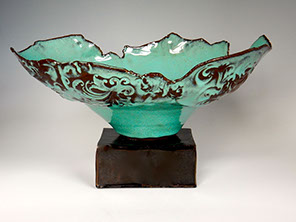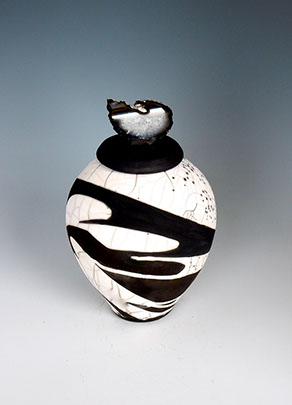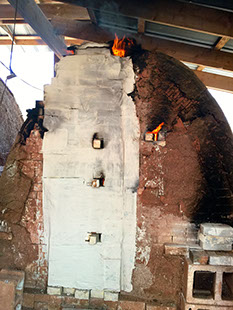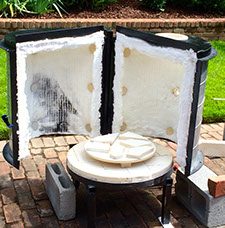Under the Scope
BEV ANDREWS
With an interest in cultural diversity and indigenous art stemming from her graduate work in sociology, Bev took advantage of her extensive world travel as an expert in international telecommunications regulation and trade to explore art around the world.
Her pottery reflects the diversity of art and geographical regions she visited. The beauty of oceans, mountain ranges and tropical forests inspired undulating rims forming waves on her bowls and bold geometric lines calling to mind mountain ranges. Look for patterns of leaves, flowers, and wood on her pots. The handles of her lidded vessels may be wood, bamboo, coral, or rock—all of which she collects! The shapes of her vessels reflect her interest in African, Asian, and Native American art.
Bev succeeds in making each piece of pottery unique! Using a variety of hand building techniques combined with the pottery wheel, she creates new and interesting forms. “I love the incredible diversity that clay allows and how freeing working with clay is. If something doesn’t work, you just ball the clay up and try something else!”
In addition to exploring new forms, Bev also looks for way to alter surfaces. She sometimes carves the clay or presses stamps or leaves into it. She also uses different firing methods, but most of her work is raku. Raku, meaning “joy,” was developed in Japan during the 16th c. Unlike other firing methods, pots are removed from a kiln with tongs while they are molten hot. Each pot is placed in a fireproof chamber (she uses metal trashcans) containing an organic material such as leaves, sawdust, or newspaper. Particularly striking are her black and white raku vessels. They have no glaze so are called “naked” raku. The white is the clay and the black is carbon produced by the combustion of organic materials in the trashcan.
Raku fired vessels are not food safe and don’t hold water, so she also uses other firing methods. Most of her functional bowls and vases are fired in an electric kiln. When she wants a different effect, she fires in a multi-chambered wood kiln called a noborigama kiln developed by the Japanese in the 17th c. Each chamber must reach about 2500 F so wood must be thrown continuously into the firebox—generally for 24 hrs or even 3 weeks! The firing creates ash that settles on pots in different ways depending on how the flame is carried through the kiln and where the pot is placed.
Born in N.Y., Bev has lived in Alexandria, VA for 30 years. She was juried into Scope in 2011 and also is a juried Torpedo Factory artist. She has been juried into Art League Gallery exhibits and shows in MD and VA. She likes Scope “because of the range of pottery always on display. It is amazing to see the great work created by the many different Scope artists!”

Altered Form Fired in Electric Kiln

Naked Raku

Wood Firing in Progress

Bev's Raku Kiln
Scope Gallery
Torpedo Factory Art Center
105 N. Union St.
Ground Floor, Studio 19
Alexandria, Va 22314
Phone: 703-548-6288
Winter 2022 Hours:
11:00 a.m. - 5:30 p.m. Thursday - Sunday
Check the Torpedo Factory website for any changes to the building open hours. www.torpedofactory.org/todays-hours/

